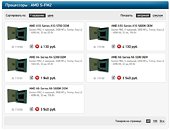Tuesday, September 25th 2012

First Socket FM2 APUs Spotted in Russian Store
Ahead of their October 1 launch, upcoming second-generation AMD A-Series APUs are beginning to surface on retailers. Russian online store Regard.ru listed most of these chips, albeit in their OEM (chip-only) packaging. According to the prices at hand, the quad-core A10-5800K and A10-5700 are listed for 4,130 RUB (US $132.6). The A8-5600K and A8-5500 quad-core APUs go for 3,540 RUB (US $114). The cheapest of the lot, dual-core A4-5300 is priced at 1,940 RUB (US $62.2).
Source:
Overclockers Ukraine

30 Comments on First Socket FM2 APUs Spotted in Russian Store
Perfect for the budget lounge room media machine really, and from what ive read, although in the last release the cpu performance side of things could be approximated to one third the power of a core i5, the igpu was quite a bit better than the intel hd4000, so for the prices, i think they offer good price/perf characteristics for those who haven't big $ to spend!
I get the feeling down the track these chips will excell, and i hope they do, some even oc!
Just hope desktop isn't going to sit around with as few board makers for months. Competition is good!
www.tomshardware.com/reviews/a10-5800k-a8-5600k-a6-5400k,3224-17.html
www.tomshardware.com/reviews/a10-5800k-a8-5600k-a6-5400k,3224-15.html
Muropaketti news post:
translate.google.com/translate?sl=fi&tl=en&js=n&prev=_t&hl=en&ie=UTF-8&layout=2&eotf=1&u=http%3A%2F%2Fmuropaketti.com%2Famdn-trinity-apu-piirien-suomi-hinnat-listattu-muropaketin-hintavertailussa (Google Translate=
AMD A10-5800K: 130,25 €
AMD A8-5600K: 108,25 €
AMD A6-5400K: 72,05 €
AMD A5-5300: 58,15 €
Usually 10-20 € cheaper in Germany
The Trinity A6-4400M is a dual core, the is Llano A6-4400M is a quad core.
Regarding Trinity performance: think of Trinity "modules" as a single hyper-threaded core. A "quad-core" (two "module") Trinity such as A10-5800K should perform along the lines of Intel's i3 Sandy or Ivy bridge chips (due to come out soon) in multithreaded tasks, lose in single-threaded tasks (only Crapple still does the single-threaded shit in 2012 ...) and win in iGPU-based gaming, while costing about the same.
As most people don't need *that much* single-threaded performance to notice any difference they will be better off with a Trinity chip than with i3 Sandy?ivy Bridge (both of which are a dead end with socket 1155, while Trinity's successor Kaveri *might* still be FM2 compatible).
Generally speaking if the CPU isn't powerful enough it will bottleneck the IGP or even a dedicated GPU.
The Llano A8-3550MX makes up for having a slower CPU by having two additional cores, thus driving its IGP more efficiently and performing better in modern muilti-threaded games.I'm not sure that is accurate. The only way you could measure which CPU is faster is to run them both at the same clock speed and disable two cores on the A6-3400M. But I haven't seen any review do that.
The review in your signature shows primarily gaming tasks which isn't a pragmatic way to isolate just CPU performance.
Even in your review, the only two non-gaming tasks are handbrake and Winzip which basically shows a 2 core Trinity vs a 4 core Llano, Trinity is unfairly handicapped as it's only a dual core. Your own review confirms this.
The review in Atom_Anti signature:Again show me a review of a 4 core Trinity vs a 4 core Llano and lets see whom is faster ;)
Every other commercial reviewer from Tom's Hardware, Hexus, Trusted Reviewer, Hot Hardware, Legit review and many others all show the Trinity 4 core outperforming the Llano 4 core both in gaming and non gaming tasks. They all have 10+ benchmarks unfortunately I'm more inclined to take their results more seriously.
If you are willing to review the desktop Trinity on release and are able to give us 10+ bechmarks (gaming and non-gaming) I will be interested to read it.
CPU is made up of CPU core, Cache, NorthBridge, and GPU.
So there are four parts, and you need to find tests that shows differences for each part. Why does each part matter? That is what your tests should show.
I run on average 4-8 benchmarks on top of the normal benchmarks that I am constantly posting in my reviews, and I use these other benchmarks simply for the purpose of to see if they fit in reviews, and convey what I want to show. They change ALL THE TIME.
Iguess what I'm saying is that asking what benchmarks people want to see may not exactly fit the bill...you may under up running a bunch of useless benchmarks that show no differences at all...
All CPUs reviewed are at the same clock speed and the same number of cores.
For CPU-dependant synthetics, I like to see a varied range. Between 10-20 different benchmarks. Wprime, Cinebench, Pass Mark Vantage: Productivity score, 7Zip, WinRar, TrueCrypt, x264 HD, Handbrake. Just to name a few. There are many more good ones.
Another important thing is to do each benchmark twice. Once in single threaded mode and once in multi threaded mode. (usually in the options you can customise the threads/cores utility)
For testing the gaming performance of the APU, it's going to be difficult to separate the affect the CPU is having on the GPU by benchmarking just in game FPS. To isolate the GPU portion use 3D Mark 2011 and Heaven DX11 - noting to only take the GPU score (not CPU, physic or overall score).
About CPU tests? That is it! What else CPU tasks people are using more commonly then compressing files and encoding video?